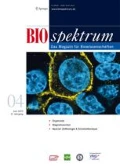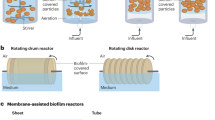Abstract
Biofilms can be considered as complex agglomerates of microorganisms which grow associated to a surface. Whereas biofilms are applied since decades for wastewater treatment, their use in biotechnological production processes is still limited. Within a recently launched project the interactions of microstructured metallic substrates with biofilm producing microorganisms are investigated. One major aim is to investigate morphology-related growth as well as productivity of different microorganisms.
Similar content being viewed by others
Literatur
Qureshi N, Annous BA, Ezeji TC et al. (2005) Biofilm reactors for industrial bioconversion processes: employing potential of enhanced reaction rates. Microb Cell Fact 4:24–45
Gross R, Lang K, Buhler K et al. (2010) Characterization of a biofilm membrane reactor and its prospects for fine chemical synthesis. Biotechnol Bioeng 105:705–717
Rosche B, Li XZ, Hauer B et al. (2009) Microbial biofilms: a concept for industrial catalysis? Trends Biotechnol 27:636–643
Howell D, Behrends B (2006) A review of surface roughness in antifouling coatings illustrating the importance of cutoff length. Biofouling 22:401–410
Scardino AJ, Harvey E, Nys R de (2006) Testing attachment point theory: diatom attachment on microtextured polyimide biomimics. Biofouling 22:55–60
Petronis S, Berntsson K, Gold J et al. (2000) Design and microstructuring of PDMS surfaces for improved marine biofouling resistance. J Biomater Sci Polym Ed 11:1051–1072
Vadillo-Rodriguez V, Busscher HJ, Norde W et al. (2004) Atomic force microscopic corroboration of bond aging for adhesion of Streptococcus thermophilus to solid substrata. J Colloid Interface Sci 278:251–254
Mitik-Dineva N, Wang J, Truong VK et al. (2009) Escherichia coli, Pseudomonas aeruginosa, and Staphylococcus aureus attachment patterns on glass surfaces with nanoscale roughness. Curr Microbiol 58:268–273
Whitehead KA, Colligon J, Verran J (2005) Retention of microbial cells in substratum surface features of micrometer and sub-micrometer dimensions. Colloids Surf B 41:129–138
van Houdt R, Michiels CW (2005) Role of bacterial cell surface structures in Escherichia coli biofilm formation. Res Microbiol 156:626–633
Author information
Authors and Affiliations
Corresponding author
Rights and permissions
About this article
Cite this article
Muffler, K., Schlegel, C., Ziegler, C. et al. Produktive Biofilme. Biospektrum 19, 216–217 (2013). https://doi.org/10.1007/s12268-013-0294-0
Published:
Issue Date:
DOI: https://doi.org/10.1007/s12268-013-0294-0




